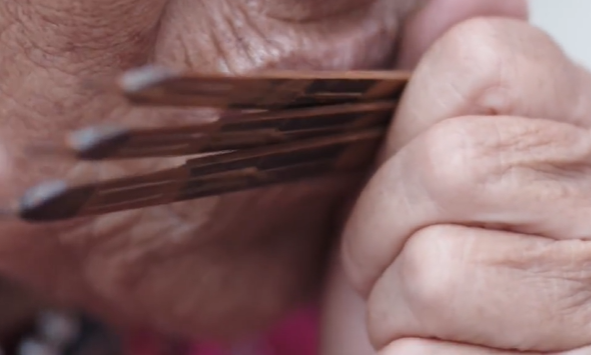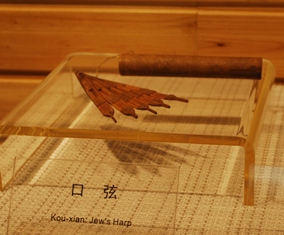Playing skills of bamboo reeds
236 views · Organized by 未知领地 on 2022-02-09
When playing, the left thumb and index finger clamp the reed tail, and the multi-leaf reed makes it fan-shaped. Place the reed tongue part between the two lips, and use the right thumb and index finger to move the head of the bamboo reed back and forth, causing the reed tongue to vibrate. A bright ding-dong sound is emitted.
Bamboo reed players use their lips to protrude forward in a cylindrical shape to increase resonance and expand the volume, and change their timbres by changing their mouth shapes and controlling their exhalation. Using different playing methods, the bamboo reed can not only produce a lingering tone, but also a rougher sound. On a pair of three-leaf springs, the pure fifth harmonic of each leaf spring can be played, and six different tones can be produced. There are many combinations of intervals, and the common ones are g, a, d1, g, c1, d1. , a, c1, d1, etc.
In my country's Dai, Hani, Jingpo, Wa, Lahu, Miao, Kirgiz, Xibo, Hui, Mongolian, Daur, Ewenki and Li and other ethnic minority folks, the bamboo springs that are plucked by fingers are popular; Reeds; Yi, Naxi, Lisu and Bai people, these two kinds of bamboo reeds are common among the people.

Bamboo reed players use their lips to protrude forward in a cylindrical shape to increase resonance and expand the volume, and change their timbres by changing their mouth shapes and controlling their exhalation. Using different playing methods, the bamboo reed can not only produce a lingering tone, but also a rougher sound. On a pair of three-leaf springs, the pure fifth harmonic of each leaf spring can be played, and six different tones can be produced. There are many combinations of intervals, and the common ones are g, a, d1, g, c1, d1. , a, c1, d1, etc.

In my country's Dai, Hani, Jingpo, Wa, Lahu, Miao, Kirgiz, Xibo, Hui, Mongolian, Daur, Ewenki and Li and other ethnic minority folks, the bamboo springs that are plucked by fingers are popular; Reeds; Yi, Naxi, Lisu and Bai people, these two kinds of bamboo reeds are common among the people.
Involving musical instruments
Bamboo spring (pinyin: zhú huáng) is also known as ringing bamboo, blowing bamboo, playing bamboo, mouth contempt, mouth spring, harmonica, mouth string. It has a long history and various forms. It is a comprehensive performance of Yi, Lahu, Naxi, Lisu, Dai, Hani, Jingpo, Wa, Brown, Nu, Dulong, Jinuo, Pumi, Miao, Tibetan, Lhoba, Qiang, Kazakh, Hui, Gaoshan, Li and Han nationalities in China. Body sounding instrument. It can play solo, unison, ensemble or accompany song and dance, and it occupies an important position in people's productive labor and daily life. Popular in Yunnan, Guizhou, Sichuan, Tibet, Xinjiang, Ningxia, Shaanxi, Guangxi, Guangdong, Taiwan, Hainan and other provinces.
 渝公网安备 50010702504639号
渝公网安备 50010702504639号